The Standard of Time—The
Twenty-Four O'Clock System
Engineering News—August 17, 1889
The 24-o'clock system has always been in use for scientific
purposes where exactness is required. The manifest and growing
objections to the present division of the day into halves and
twelfths, for travelers and in the making and interpretation of
time-tables, has led to many attempts to improve the system by
the adoption of a more convenient method. Without going into the
consideration of the merits of the different plans that have been
proposed, it will at once be acknowledged that any improvement,
to practically succeed in general use, must be simple, and contain
no radical departure from the established custom. Such is the
24 o'clock plan, which is gradually and quietly making its way
into general use.
The day is only a local phenomenon. Time is only accurately
determined by the motions of the planets. The natural divisions
determined by these are the year, month, and day. Taking the mean
solar day for the standard, or unit, and midnight on some fixed
degree of longitude on the earth, as that of Greenwich, for the
starting-point, if the earth is divided around its circumference
into 24 parts, corresponding to the 24 hours of the day, an absolute
standard of time for the whole world is secured, and this is called
Kosmic time.
By this arrangement the earth itself becomes the great standard
chronometer for all mankind, and in its daily rotations the sun
at any point will be the index of Kosmic time. For example: when
the seventeenth-hour meridian, which governs the local time of
New York or Boston, is under the sun, it is 17 o'clock, Kosmic
time; when the eighteenth-hour meridian, which governs the local
time of Chicago, is under the sun, it is 18 o'clock ; when the
nineteenth-hour meridian, which governs the local time of Denver,
it is 19 o'clock; when the twentieth-hour meridian, which governs
the local time of San Francisco, is under the sun, it is 20 o'clock
Kosmic time; and so on, all around the earth.
Kosmic time indicates universal time, based on the prime meridian,
which is Greenwich. Each of the 24 meridians into which the earth
is divided then becomes in time just 1 hour apart, as astronomers
divide the heavens. It becomes then the time of the universe,
the one measure of motion. Its hours are counted from 1 to 24
by meridians of longitude around the earth, passing in succession
under the sun. These meridians are standards for local time.
 The only change
from the present method of reckoning involved in the use of this
standard is to count the hours from 1 to 24, instead of from 1
to 12 twice each day. The advantages in simplicity and accuracy
are obvious. How to introduce this change practically, in clocks
and watches, was the only problem to solve. The construction and
operation of the Kosmic dial is as follows: A series of radial
spindles, loosely journalled at both ends, Fig. 1, carry numeral
blocks and turnstiles. The numerals are so arranged as to appear
in their proper order when the blocks are turned. The disk, mounted
on the hub of the hour-hand, keeps the numeral blocks in line
with the face-plate. It has a notch in its circumference with
a projecting pin, which passes through each turnstile in succession
once in 12 hours, thus turning the spindles, with their numeral
blocks, one-fourth of a revolution. The only change
from the present method of reckoning involved in the use of this
standard is to count the hours from 1 to 24, instead of from 1
to 12 twice each day. The advantages in simplicity and accuracy
are obvious. How to introduce this change practically, in clocks
and watches, was the only problem to solve. The construction and
operation of the Kosmic dial is as follows: A series of radial
spindles, loosely journalled at both ends, Fig. 1, carry numeral
blocks and turnstiles. The numerals are so arranged as to appear
in their proper order when the blocks are turned. The disk, mounted
on the hub of the hour-hand, keeps the numeral blocks in line
with the face-plate. It has a notch in its circumference with
a projecting pin, which passes through each turnstile in succession
once in 12 hours, thus turning the spindles, with their numeral
blocks, one-fourth of a revolution.
The power required is infinitesimal, and is taken direct from
the central power of the time-piece.
The Kosmic dial is the only method by which local and Kosmic
time can be shown simultaneously on a dial of 12 divisions. The
regular hour-hand indicates local time; the small hour-hand indicates
Kosmic time.
The railway companies of North America adopted this system
as the basis of standard time in November, 1883, and now decidedly
approve of its practical application to their time-tables and
to the dials of clocks and watches.
It is now in use on the Intercolonial Railway, for certain
through trains on the Canadian Pacific, and its adoption is extending
to other railroads. A report favorable to the adoption of this
standard was made by a committee of the American Society of Civil
Engineers, of which Mr. SANDFORD FLEMING, who has for eight or nine years taken
an active interest in advancing the new reform, was a member.
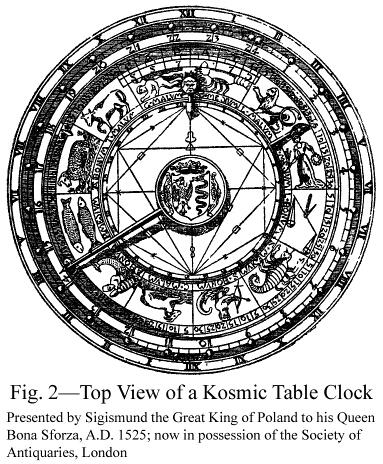 The meridian
of Greenwich, England, was established as the Prime Meridian for
longitude, and a "universal day," beginning for all
the world at Greenwich, midnight, with the hours numbered in a
single series from 1 to 24, was adopted by the leading nations
of the world, in a conference at Washington, in October, 1884. The meridian
of Greenwich, England, was established as the Prime Meridian for
longitude, and a "universal day," beginning for all
the world at Greenwich, midnight, with the hours numbered in a
single series from 1 to 24, was adopted by the leading nations
of the world, in a conference at Washington, in October, 1884.
Among the many efforts made by clock and watch manufacturers
and others, the Kosmic dial alone interprets the system with the
least possible mental and mechanical friction.
It does not change the general appearance and time mechanism
of clocks and watches. A procession of Roman numerals from I to
XII, followed automatically by a like procession of Arabic numerals
from 13 to 24, the two sets taking their places in orderly and
unvarying succession, presents to the public eye, in its simplest
and clearest expression, precisely the information needed at any
hour of the day or night. The removal or insertion of the pin
that changes the figures gives the choice between the old and
the new systems in a single time-piece.
It is said that about 4,000,000 clocks and watches are manufactured
annually, in the United States. To change either the time or mechanism
or even the general appearance of clocks and watches, would be
a herculean task. This is not at all necessary with the new standard.
Any clock or watch can be readily fitted with the new dials, and
the relative positions of the numerals in present use are not
changed.
Among those working to bring this standard into general adoption
are, besides Mr. FLEMING, Mr. W. F. ALLEN, editor of the "Traveller's Official
Railway Guide," Prof. CHARLES F. DOWD, Mr. JOHN SWAN, and Mr. HENRY E.
WAITE of Boston. Clocks, provided with
the turning figures will soon he manufactured for the market,
and sample clocks have already been made in considerable variety.
It is intended to provide the Boston Post Office with one of these
clocks, made in the shape of a globe and hung in Post Office Square,
for the better education of the public.
Figs. 3, 4, and 5 show ancient time-keepers; Fig. 6, is the
great mean solar standard clock, the time regulator of the world;
and Fig. 7, the plan by which the earth itself becomes the standard
of time.
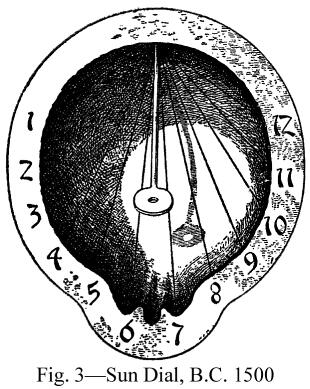 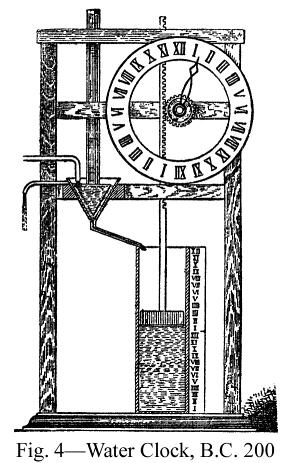
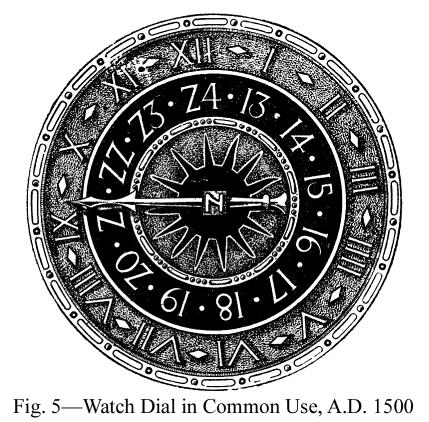 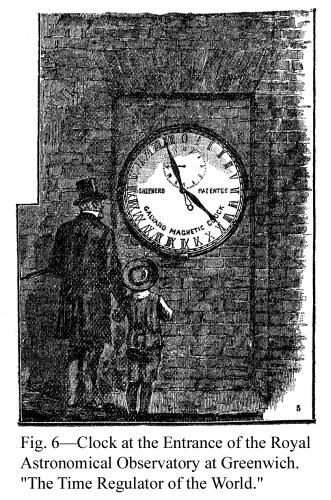
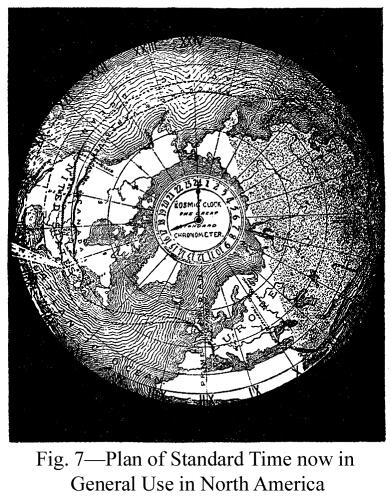
Stories Page | Contents Page
|







